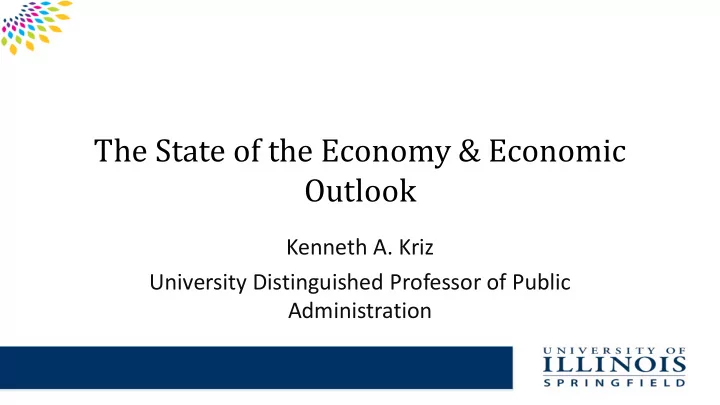

The State of the Economy & Economic Outlook Kenneth A. Kriz University Distinguished Professor of Public Administration
Outline Geographies – National – Regional – Local Sectors/Markets – Manufacturing/Output – Labor – Retail – Household Overall Indices/Measures
NATIONAL ECONOMY
Bottom Line: National Economy We have been in a relatively weak expansion since 2008-09 – Slowdowns in 2013-14 and 2016 Growth since 2016 at or near the 20-year trend growth rate There is some evidence of a slowdown lately, especially in manufacturing Labor market, retail sales, and income growth have been good, but showing signs of weakness Aggregate measures showing signs of slowing but small probability of imminent recession
National Output
National Real GDP by Decade Decade Average Real GDP Growth 1950s 4.2% 1960s 4.5% 1970s 3.2% 1980s 3.1% 1990s 3.2% 2000s 1.9% 2010s (to 2018) 2.3%
Labor Market – Unemployment Rate
Labor Market – Nonfarm Payrolls
Labor Market – Trending Nonfarm Payrolls
Average Hourly Earnings: Private Sector
Retail Sales
Per Capita Personal Income
Indices/Measures – Chicago Fed National Activity Index
Indices/Measures – Conference Board Leading/Coincident Indicators
Hamilton/Chauvret (Econbrowser) Recession Index
Survey of Professional Forecasters Quarter or Year/Measure Real GDP Growth Unemployment Rate Nonfarm Payrolls Q4 2019 2.00% 3.60% 148,100 Q1 2020 1.95% 3.63% 137,600 Q2 2020 1.98% 3.60% 145,800 Q3 2020 1.98% 3.69% 108,300 Annual 2020 1.94% 3.62% 141,200 Annual 2021 2.03% 3.85% Annual 2022 2.09% 4.00%
Common Concerns in Forecasts Trade/World Tensions Manufacturing Sector Policy Uncertainty Rising Debt Levels (mainly public) Monetary Policy Limits
REGIONAL ECONOMY
Bottom Line: Regional Economy Similar story to national picture, trend output growth with some concern in near term Declining unemployment rate, increasing payroll employment and earnings point to strong labor market Strong gains in personal income since 2016 but also near- term concerns More volatility in the Iowa economy, which is also growing more slowly Indices point to moderate growth in the next year or so
Regional Output
Regional Unemployment Rate
Regional Payroll Employment
Regional Average Hourly Earnings
Regional Personal Income
Philadelphia Fed Coincident and Leading Indices, September 2019 Index/State Illinois Iowa Missouri Coincident (12 month change) 2.54% 1.71% 1.74% Leading (Predicted 6-month change in Coincident Index) 1.32% 0.58% 1.14%
LOCAL ECONOMY
Bottom Line: Local Economy Output recession in 2013-2016 looks to be lessening Output and employment growth has been centered around Business and Professional Services, FIRE (output only), and Construction Labor markets show similar trends to the regional economy Personal income growth has been solid, but recent trends in average hourly earnings are a source of concern The structure of the local economy is a source of risk in the medium-to-long-term
Local Output
MSA Output Growth by Sector Since 2010 Construction 1.48% Manufacturing 0.32% Wholesale trade -5.37% Retail trade 0.05% Transportation and warehousing (since 2013) -0.36% Information -6.09% Finance, insurance, real estate, rental, and leasing 1.66% Professional and business services (to 2016) 2.49% Educational services, health care, and social assistance (to 2016) 0.98% Arts, entertainment, recreation, accommodation, and food services 0.66% Government and government enterprises -1.25%
Local Unemployment Rate
Local Payroll Employment
MSA Payroll Employment Growth by Industry Since 2010 3.48% Mining, Logging, and Construction Manufacturing 0.99% Trade, Transportation, and Utilities -0.15% -5.25% Information Financial Activities -1.30% Professional and Business Services 1.92% 0.17% Education and Health Services Leisure and Hospitality 0.66% Other Services 0.00% -0.99% Government
MSA Average Hourly Earnings
MSA Personal Income
Employment & Output Projections through 2028 for “Export”/”Import” Industries " Export" Industries Projected Output Projected Sub-Sector Location Quotient Growth Employment Growth NAICS 331 Primary metal manufacturing 7.2 1.6% -1.3% NAICS 562 Waste management and remediation services 2.82 2.2% 0.5% NAICS 311 Food manufacturing 2.42 1.8% 0.0% NAICS 484 Truck transportation 1.75 2.3% 0.4% NAICS 221 Utilities 1.71 1.2% -0.3% NAICS 332 Fabricated metal product manufacturing 1.57 1.4% -0.3% NAICS 423 Merchant wholesalers, durable goods 1.36 2.7% -0.2% NAICS 811 Repair and maintenance 1.22 1.2% 0.3% "Import" Industries Projected Output Projected Sub-Sector Location Quotient Growth Employment Growth NAICS 236 Construction of buildings 0.78 1.0% 1.1% NAICS 424 Merchant wholesalers, nondurable goods 0.78 2.7% -0.2% NAICS 624 Social assistance 0.64 2.7% 2.0% NAICS 486 Pipeline transportation 0.62 1.8% 0.2% NAICS 321 Wood product manufacturing 0.58 1.2% -0.5% NAICS 511 Publishing industries, except internet 0.53 3.9% 0.1% NAICS 531 Real estate 0.44 2.4% 0.5% NAICS 523 Securities, commodity contracts, investments 0.32 1.7% 0.4% NAICS 512 Motion picture and sound recording industries 0.31 0.4% 0.5% NAICS 314 Textile product mills 0.3 1.5% -1.9%
ADDITIONAL SLIDES
Labor Market – Private Payrolls
Recommend
More recommend